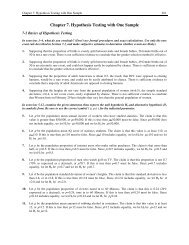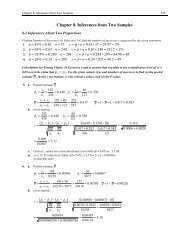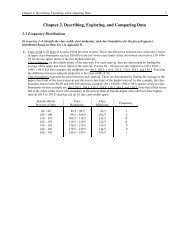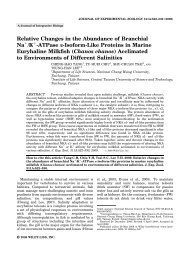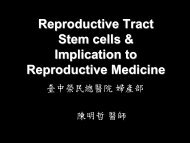Photomorphogenesis: Responding to light
Photomorphogenesis: Responding to light
Photomorphogenesis: Responding to light
Create successful ePaper yourself
Turn your PDF publications into a flip-book with our unique Google optimized e-Paper software.
<strong>Pho<strong>to</strong>morphogenesis</strong>: Growthresponses <strong>to</strong> <strong>light</strong>•Light is an important environmental signalthat plants use <strong>to</strong> regulate their growth anddevelopment.•Both the quality and quantity of <strong>light</strong> areimportant.•The regulation of plant development by<strong>light</strong> is called pho<strong>to</strong>morphogenesis.
Pho<strong>to</strong>recep<strong>to</strong>rs inpho<strong>to</strong>morphogenesis•There are four classes of plant pho<strong>to</strong>recep<strong>to</strong>rs.–Phy<strong>to</strong>chromes absorb red (660 nm) and far red <strong>light</strong> (735nm).–Cryp<strong>to</strong>chromes detect blue (400-450 nm) and UV-A <strong>light</strong>(320-400 nm).–Pho<strong>to</strong>tropins also detect blue and UV-A <strong>light</strong>.–A newly-identified class of pho<strong>to</strong>recep<strong>to</strong>rs that responds <strong>to</strong>low levels of UV-B <strong>light</strong>.•The first three pho<strong>to</strong>recep<strong>to</strong>rs are chromoproteins,meaning that they are a complex (holoprotein)consisting of a pigment (chromophore) and acatalytic protein (apoprotein).
Phy<strong>to</strong>chromes
Phy<strong>to</strong>chromes•The pho<strong>to</strong>reversibility of phy<strong>to</strong>chrome isa unique aspect of phy<strong>to</strong>chrome.•Plant responses <strong>to</strong> red <strong>light</strong> can benullified with an immediate treatment withfar-red <strong>light</strong>.
Phy<strong>to</strong>chromes
Phy<strong>to</strong>chromes•Pho<strong>to</strong>reversibility occurs because the two formsof phy<strong>to</strong>chrome are in a pho<strong>to</strong>equilibriumcreated by <strong>light</strong>.
Phy<strong>to</strong>chromes•The dynamic relationship between the Prand Pfr forms can be seen clearly inetiolated (dark-grown) plants.
Phy<strong>to</strong>chromes
Phy<strong>to</strong>chromes•The loss of phy<strong>to</strong>chrome following a redirradiation can be explained by two fac<strong>to</strong>rs:
Phy<strong>to</strong>chromes•The pho<strong>to</strong>equilibrium (is describedmathematically by:= PPfrTOTWhere P TOT is the sum of the Pr and Pfr forms•Light conditions dictate the specific ratio.–Under pure red <strong>light</strong>, = 0.8 (80% pFr).–Under pure far-red <strong>light</strong>, = 0.03 (3% pFr).–In sun<strong>light</strong>, the value of will change through the day.
Phy<strong>to</strong>chromes•The proportion of Pfr will depend on atleast three fac<strong>to</strong>rs:-the relative proportions of red and far-redwavelengths in the <strong>light</strong> source-the forward and reverse rates ofpho<strong>to</strong>conversion between Pr and Pfr-the rate of thermal reversion of Pfr <strong>to</strong> Pr
Phy<strong>to</strong>chromes•Phy<strong>to</strong>chrome responses are groupedbased upon their fluence requirement.–Low fluence responses (LFRs) arestimulated by <strong>light</strong> doses in the 1 –1,000mole <strong>light</strong> m -2 and are FR-reversible.–Very low fluence responses (VLFRs) areirreversible responses <strong>to</strong> <strong>light</strong> levels of 10 -6 <strong>to</strong>10 -3 mole <strong>light</strong> m -2 and are notpho<strong>to</strong>reversible.–High irradiance reactions (HIRs) are thosethat respond <strong>to</strong> sustained exposures <strong>to</strong> <strong>light</strong>.
Cryp<strong>to</strong>chromes•Cryp<strong>to</strong>chromes mediate the growth responses<strong>to</strong> blue and UV-A <strong>light</strong>, including aspects of deetiolationsuch as the inhibition of hypocotylelongation and stimulation of cotyledonexpansion, gene expression, flowering time…...
Cryp<strong>to</strong>chromes•Examples of blue <strong>light</strong> pho<strong>to</strong>recep<strong>to</strong>rs include:–Cryp<strong>to</strong>chrome 1 (cry1), a recep<strong>to</strong>r which bindsflavins such as FAD (flavin adenine dinucleotide).–The Arabidopsis cry1 mutant had lost the capacity<strong>to</strong> respond <strong>to</strong> blue <strong>light</strong>–Cryp<strong>to</strong>chrome 2 (cry2) mediates blue-<strong>light</strong>suppression of hypocotyl elongation, cotyledonexpansion, and anthocyanin production.–Cry2 has a role in determining flowering time
Developmental responses mediated byphy<strong>to</strong>chrome and cryp<strong>to</strong>chrome•Seed germination is influenced by <strong>light</strong>.
Developmental responses mediated byphy<strong>to</strong>chrome and cryp<strong>to</strong>chrome•Specific changes occur when dark-grownplants are exposed <strong>to</strong> <strong>light</strong> (de-etiolation).
Developmental responses mediated byphy<strong>to</strong>chrome and cryp<strong>to</strong>chrome
Developmental responses mediated byphy<strong>to</strong>chrome and cryp<strong>to</strong>chrome•Shading triggers changes in plant growth.
Developmental responses mediated byphy<strong>to</strong>chrome and cryp<strong>to</strong>chrome
Developmental responses mediated byphy<strong>to</strong>chrome and cryp<strong>to</strong>chrome
Developmental responses mediated byphy<strong>to</strong>chrome and cryp<strong>to</strong>chrome•Phy<strong>to</strong>chrome is the recep<strong>to</strong>r that helpsplants detects end-of-day signals.
Developmental responses mediated byphy<strong>to</strong>chrome and cryp<strong>to</strong>chrome•Biosynthesis of the red-blue anthocyaninpigments are mediated by <strong>light</strong>.
Developmental responses mediated byphy<strong>to</strong>chrome and cryp<strong>to</strong>chrome•Some phy<strong>to</strong>chrome responses occurwithin a matter of seconds <strong>to</strong> minutes andtypically involve membrane-basedchanges in bioelectric potential or ion flux.
Developmental responses mediated byphy<strong>to</strong>chrome and cryp<strong>to</strong>chrome•The different forms of phy<strong>to</strong>chrome likelyhave different fundamental roles in theperception of <strong>light</strong>.
Mode of action of phy<strong>to</strong>chrome
Mode of action of phy<strong>to</strong>chrome•The apoprotein for phy<strong>to</strong>chrome is a smallpeptide.–The peptide has a pho<strong>to</strong>sensory domain onthe N-terminus and a regula<strong>to</strong>ry domain atthe C-terminus.–The regula<strong>to</strong>ry domain contains a sub-domainwith characteristics of a histidine kinase.–Phy<strong>to</strong>chrome, in a sense, acts as a twocomponentregula<strong>to</strong>ry system like thoseinvolved in hormone sensing.
Mode of action of phy<strong>to</strong>chrome
Mode of action of phy<strong>to</strong>chrome•The mechanism by which phy<strong>to</strong>chromemediates plant development involves threeimportant fac<strong>to</strong>rs.
Mode of action of phy<strong>to</strong>chrome•Phosphorylation is key <strong>to</strong> the signaling roleof phy<strong>to</strong>chromes.
Mode of action of phy<strong>to</strong>chrome•The migration of phy<strong>to</strong>chrome <strong>to</strong> thenucleus also provides control of geneexpression.
Mode of action of phy<strong>to</strong>chrome•Figure 22.11
Mode of action of phy<strong>to</strong>chrome•The migration of phy<strong>to</strong>chrome <strong>to</strong> thenucleus also provides control of geneexpression.
Mode of action of phy<strong>to</strong>chrome•Figure 22.12
Mode of action of cryp<strong>to</strong>chrome•The structure of cryp<strong>to</strong>chromes is similar<strong>to</strong> that of DNA repair enzymes.
Mode of action of cryp<strong>to</strong>chrome
Mode of action of cryp<strong>to</strong>chrome
Mode of action of cryp<strong>to</strong>chrome•The mechanism by which cryp<strong>to</strong>chromeelicits developmental responses has notbeen fully characterized.
Mode of action of cryp<strong>to</strong>chrome•The mechanism by which cryp<strong>to</strong>chrome elicitsdevelopmental responses has not been fullycharacterized.
Plant responses <strong>to</strong> UV-B <strong>light</strong>•Examples of UV-B responsive process inplants include:–An increase in anthocyanin production–An increase in flavonoid biosynthesis,triggered by phy<strong>to</strong>chrome, cryp<strong>to</strong>chrome, andanother UV-B recep<strong>to</strong>r.
Interactions between phy<strong>to</strong>chromeand cryp<strong>to</strong>chrome•De-etiolation responses in Arabidopsisinvolve an interaction between phyA, phyB,and cry1.–If phyB is defective, hypocotyl elongation issuppressed.–If phyA is also deficient, the hypocotyls areeven longer than in etiolated plants.–In a triple mutant which includes a defect incry1, the hypocotyl hook does not straightenand the cotyledons do not unfold.
Interactions between phy<strong>to</strong>chrome•Figure 22.15and cryp<strong>to</strong>chrome





